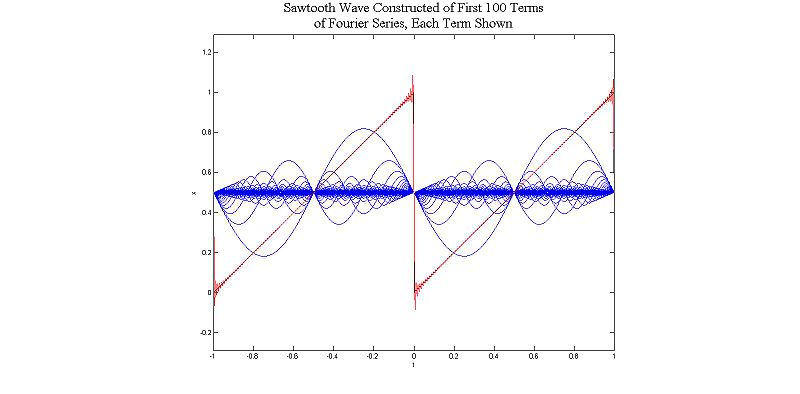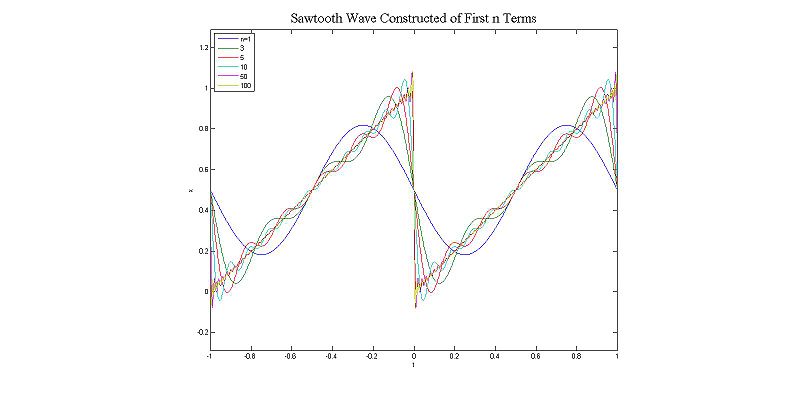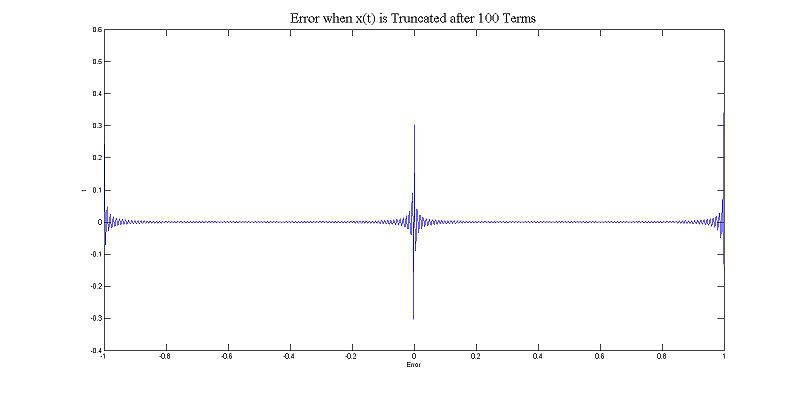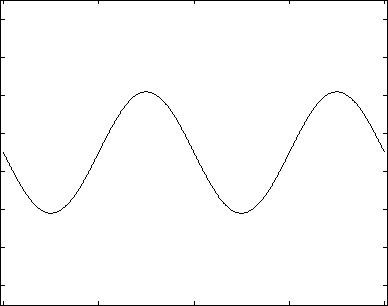Exercise: Sawtooth Wave Fourier Transform: Difference between revisions
John.hawkins (talk | contribs) (First bit of work) |
No edit summary |
||
| (13 intermediate revisions by 3 users not shown) | |||
| Line 17: | Line 17: | ||
<br /> |
<br /> |
||
<center><math> x(t)=\sum^\infty_{n= |
<center><math> x(t)=\frac{a_0}{2}+\sum^\infty_{n=1} \left[a_n\cos\frac{2\pi nt}{T}+b_n\sin\frac{2\pi nt}{T}\right]</math></center> |
||
<br /> |
<br /> |
||
| Line 35: | Line 35: | ||
<br /> |
<br /> |
||
For the sawtooth function given, we note that <math>T=1</math>, and an obvious choice for <math>c</math> is 0. It remains, then, only to find the expression for <math>a_n</math> and <math>b_n</math>. We proceed first to find <math>b_n</math>. |
For the sawtooth function given, we note that <math>T=1</math>, and an obvious choice for <math>c</math> is 0 since this allows us to reduce the equation to <math>x(t)=t</math>. It remains, then, only to find the expression for <math>a_n</math> and <math>b_n</math>. We proceed first to find <math>b_n</math>. |
||
<br /> |
<br /> |
||
| Line 81: | Line 81: | ||
</center> |
</center> |
||
Now, for <math>a_n</math> we must consider the case when <math>n=0</math> separately. |
|||
Now, for |
|||
<br /> |
|||
<center> |
|||
<math>a_0=\frac{2}{1}\int_0^1t\ dt=t^2\bigg|_0^1=1</math> |
|||
</center> |
|||
<br /> |
|||
For <math>n=1,2,3\dots</math>, we have |
|||
<br /> |
|||
<center> |
|||
<math>a_n=\frac{2}{1}\int_0^1t\cos 2\pi nt\ dt</math> |
|||
</center> |
|||
<br /> |
|||
which again is best solved using integration by parts, this time with |
|||
<br /> |
|||
<center> |
|||
<math>u=t\qquad\Rightarrow\qquad du=dt</math> |
|||
<br /> |
|||
<math>dv=\cos 2\pi nt\ dt\qquad \Rightarrow\qquad v=\frac{1}{2\pi n}\sin 2\pi nt</math> |
|||
<br /> |
|||
</center> |
|||
so |
|||
<br /> |
|||
<center> |
|||
<math>a_n=2\left[t\left(\frac{1}{2\pi n}\right)\sin 2\pi nt\bigg|_0^1-\int_0^1\frac{1}{2\pi n}\sin 2\pi nt\ dt\right]</math> |
|||
<br /> |
|||
<math>=2\left[\left(\frac{1}{2\pi n}\sin 2\pi n-0\right)-\left[-\left(\frac{1}{2\pi n}\right)^2\cos 2\pi nt\right]_0^1\right]</math> |
|||
<br /> |
|||
<math>=2\left[0+\left(\frac{1}{2\pi n}\right)^2\left(\cos 2\pi n-\cos 0\right)\right]</math> |
|||
<br /> |
|||
<math>\ =0</math> |
|||
</center> |
|||
<br /> |
|||
Therefore, the Fourier Transform representation of the sawtooth wave given is: |
|||
<br /> |
|||
<center><math>x(t)=\frac{1}{2}-\sum_{n=1}^\infty \frac{1}{\pi n}\sin 2\pi nt</math></center> |
|||
<br /> |
|||
==Solution Graphs== |
|||
The figures below graph the first few iterations of the above solution. The first graph shows the solution truncated after the first 100 terms of the infinite sum, as well as each of the contributing sine waves with offset. The second figure shows the function truncated after 1, 3, 5, 10, 50, and 100 terms. The last figure shows the Error between the Fourier Series truncated after the first 100 terms and the function itself. These figures were constructed using the following matlab code: [[SawToothFourier]]. |
|||
<br /> |
|||
[[Image:First_100_Terms.jpg|thumb|800px|center]] |
|||
<br /> |
|||
[[Image:First_n_Terms.jpg|thumb|800px|center]] |
|||
<br /> |
|||
[[Image:Error.jpg|thumb|800px|center]] |
|||
<br /> |
|||
[[Image:Sawtooth.gif|thumb|800px|Solution as number of terms varies from 1 to 30.|center]] |
|||
==Author== |
==Author== |
||
| Line 88: | Line 175: | ||
==Read By== |
==Read By== |
||
[[Lau, Chris|Christopher Garrison Lau I]] |
|||
==Reviewed By== |
==Reviewed By== |
||
Colby Fullerton |
|||
*[[Vier, Michael | Michael Vier]] |
|||
Latest revision as of 21:37, 17 January 2010
Problem Statement
Find the Fourier Tranform of the sawtooth wave given by the equation
Solution
As shown in class, the general equation for the Fourier Transform for a periodic function with period is given by
where
For the sawtooth function given, we note that , and an obvious choice for is 0 since this allows us to reduce the equation to . It remains, then, only to find the expression for and . We proceed first to find .
which is solved easiest with integration by parts, letting
so
Now, for we must consider the case when separately.
For , we have
which again is best solved using integration by parts, this time with
so
Therefore, the Fourier Transform representation of the sawtooth wave given is:
Solution Graphs
The figures below graph the first few iterations of the above solution. The first graph shows the solution truncated after the first 100 terms of the infinite sum, as well as each of the contributing sine waves with offset. The second figure shows the function truncated after 1, 3, 5, 10, 50, and 100 terms. The last figure shows the Error between the Fourier Series truncated after the first 100 terms and the function itself. These figures were constructed using the following matlab code: SawToothFourier.
Author
John Hawkins
Read By
Reviewed By
Colby Fullerton


![{\displaystyle x(t)={\frac {a_{0}}{2}}+\sum _{n=1}^{\infty }\left[a_{n}\cos {\frac {2\pi nt}{T}}+b_{n}\sin {\frac {2\pi nt}{T}}\right]}](https://wikimedia.org/api/rest_v1/media/math/render/svg/04bac4a13740a6ddbef45506c7c22a4db2c9aad8)









![{\displaystyle b_{n}=2\left[t\left(-{\frac {1}{2\pi n}}\right)\cos 2\pi nt{\bigg |}_{0}^{1}+{\frac {1}{2\pi n}}\int _{0}^{1}\cos 2\pi nt\ dt\right]}](https://wikimedia.org/api/rest_v1/media/math/render/svg/233867d3cc9632255b92139ff09a3604bb5b6683)
![{\displaystyle =2\left[\left(-{\frac {1}{2\pi n}}\cos 2\pi n-0\right)+\left({\frac {1}{2\pi n}}\right)^{2}\sin 2\pi nt{\bigg |}_{0}^{1}\right]}](https://wikimedia.org/api/rest_v1/media/math/render/svg/0e0c18b2e8b52515773779ca17a4f2b714c90b97)
![{\displaystyle =2\left[-{\frac {1}{2\pi n}}(1)+0\right]}](https://wikimedia.org/api/rest_v1/media/math/render/svg/68609662576139dfd8a75c771f5ef7397ee879e2)






![{\displaystyle a_{n}=2\left[t\left({\frac {1}{2\pi n}}\right)\sin 2\pi nt{\bigg |}_{0}^{1}-\int _{0}^{1}{\frac {1}{2\pi n}}\sin 2\pi nt\ dt\right]}](https://wikimedia.org/api/rest_v1/media/math/render/svg/689bb819034a37bed8e33ca2fd67db4be2138c5c)
![{\displaystyle =2\left[\left({\frac {1}{2\pi n}}\sin 2\pi n-0\right)-\left[-\left({\frac {1}{2\pi n}}\right)^{2}\cos 2\pi nt\right]_{0}^{1}\right]}](https://wikimedia.org/api/rest_v1/media/math/render/svg/f4e3c75b2c5a0eafcd3262ae71df726aac01f548)
![{\displaystyle =2\left[0+\left({\frac {1}{2\pi n}}\right)^{2}\left(\cos 2\pi n-\cos 0\right)\right]}](https://wikimedia.org/api/rest_v1/media/math/render/svg/66cd9e52e98d0341fa22b5aa9410305d3a91c5a9)





